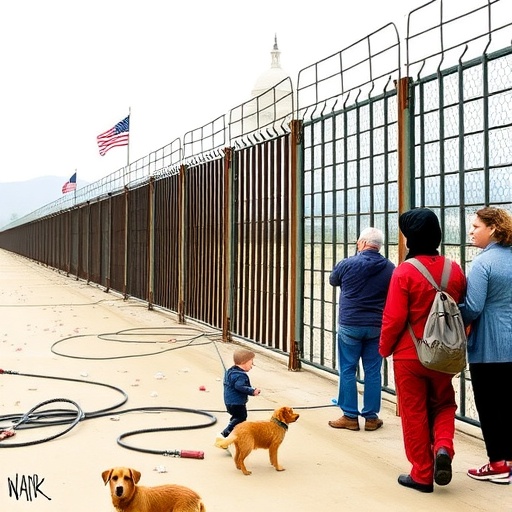Senate Democrats Advance Immigration reform Bill Tackling Border Security and Citizenship Amid Crisis
In a bold move to address the escalating border crisis, Senate Democrats on Tuesday introduced a comprehensive Immigration reform bill that promises enhanced border security measures alongside a structured pathway to citizenship for undocumented immigrants. The legislation, dubbed the Border Security and Opportunity Act, arrives at a pivotal moment as migrant encounters at the U.S.-Mexico border have surged to record levels, with U.S. Customs and Border Protection reporting over 2.4 million encounters in fiscal year 2023 alone. This push by Democrats highlights a renewed urgency in Washington to overhaul the nation’s fractured immigration system, even as Republicans decry the bill’s provisions and timing as politically motivated.
- Democrats Outline Robust Border Security Enhancements in New Bill
- Pathway to Citizenship Ignites Controversy Over Undocumented Immigrants’ Future
- Republicans Fire Back on Bill’s Timing and Provisions During Border Surge
- Border Communities and Advocacy Groups Weigh In on Reform Push
- Navigating Legislative Hurdles: What Lies Ahead for Immigration Reform
The bill’s introduction comes amid heated debates in the Senate, where Democrats hold a slim majority. Led by Senate Majority Leader Chuck Schumer, the legislation aims to balance humanitarian concerns with national security imperatives, incorporating investments in technology and personnel for border security while offering legal status to long-term residents. However, with the Republican-controlled House and a divided Congress, the bill’s path to becoming law remains fraught with obstacles.
Democrats Outline Robust Border Security Enhancements in New Bill
At the heart of the Democrats’ Immigration reform initiative is a multifaceted approach to bolster border security, addressing what proponents call a humanitarian and enforcement crisis. The bill allocates $25 billion over five years for advanced surveillance technologies, including AI-driven monitoring systems and drone patrols along the 2,000-mile U.S.-Mexico border. “We can’t ignore the chaos at our borders any longer,” Schumer declared during a press conference on Capitol Hill. “This legislation invests in smart, effective border security that protects our communities without tearing families apart.”
Key provisions include hiring 5,000 additional Border Patrol agents and expanding detention facilities to handle increased migrant flows. The bill also mandates the completion of 700 miles of border barriers in high-traffic areas, a nod to bipartisan concerns over physical infrastructure. According to data from the Department of Homeland Security, unauthorized crossings have overwhelmed resources, leading to over 1.5 million expulsions under Title 42 during the pandemic era. Democrats argue that these measures will reduce illegal entries by up to 40%, citing similar investments in past reforms like the 2006 Secure Fence Act.
Environmental safeguards are woven into the border security framework, requiring assessments to minimize ecological damage in sensitive areas like the Rio Grande Valley. Advocacy groups such as the Sierra Club have praised this inclusion, noting that unchecked development could harm endangered species habitats. Yet, the funding breakdown—60% for technology and personnel, 30% for infrastructure, and 10% for environmental protections—has sparked internal Democratic debates, with progressives pushing for more emphasis on root causes like climate change in Central America.
Pathway to Citizenship Ignites Controversy Over Undocumented Immigrants’ Future
A cornerstone of the bill is its pathway to citizenship, designed to provide legal status to an estimated 11 million undocumented immigrants living in the U.S. Under the proposed legislation, individuals who have resided in the country for at least five years, pass background checks, and demonstrate good moral character could apply for green cards within three years. Full citizenship would follow after an additional five years of lawful permanent residency, contingent on paying back taxes and learning English.
“This is about fairness and economic contribution,” said Sen. Dick Durbin (D-IL), a longtime champion of immigration reform. “These are workers, families, and neighbors who have built our economy—it’s time to bring them out of the shadows.” The provision draws inspiration from the 2013 Border Security, Economic Opportunity, and Immigration Modernization Act, which passed the Senate but stalled in the House. Economists from the Congressional Budget Office estimate that legalizing this workforce could add $1.5 trillion to GDP over the next decade through increased tax revenues and consumer spending.
However, the citizenship pathway has drawn sharp rebukes from immigrant rights organizations. The ACLU warns that stringent requirements, including a $2,000 application fee, could exclude low-income families. Statistics from the Migration Policy Institute show that 70% of undocumented immigrants earn below the median wage, making such fees a barrier. Conversely, business groups like the U.S. Chamber of Commerce support the measure, highlighting labor shortages in agriculture and construction sectors where immigrants fill critical roles.
Republicans Fire Back on Bill’s Timing and Provisions During Border Surge
Republican senators wasted no time in criticizing the Democrats’ immigration reform bill, labeling it a partisan stunt amid the ongoing border crisis. Senate Minority Leader Mitch McConnell (R-KY) called the legislation “tone-deaf,” arguing that it rewards illegal immigration at a time when border agents are stretched thin. “Democrats are pushing this bill not to solve problems, but to score political points before the midterms,” McConnell stated in a floor speech. He pointed to recent reports of over 300 daily migrant encounters in sectors like San Diego, where local resources are overwhelmed.
GOP lawmakers, including Sen. Ted Cruz (R-TX), have zeroed in on specific provisions they deem insufficient. Cruz, representing a border state, slammed the bill’s asylum reforms as too lenient, noting that it would expedite claims but not impose stricter initial screenings. “We’ve seen fentanyl pouring across the border—over 100,000 overdose deaths last year linked to this crisis,” Cruz said, referencing CDC data. Republicans propose amendments to defund sanctuary cities and impose harsher penalties on human smugglers, measures absent from the Democratic draft.
The timing critique resonates in Republican strongholds, where polls from Fox News show 65% of voters view the border situation as a national emergency. House Republicans, led by Speaker Kevin McCarthy, have vowed to block any bill that includes amnesty-like citizenship paths, echoing the 2013 failure. This partisan divide underscores the challenges in a Senate where Democrats need at least 60 votes to overcome a filibuster, requiring some GOP buy-in.
Border Communities and Advocacy Groups Weigh In on Reform Push
Voices from the front lines of the border crisis are adding layers to the immigration reform debate. In El Paso, Texas, local officials report a 200% increase in shelter demands since 2021, straining municipal budgets by millions. Mayor Oscar Leeser, a Democrat, endorsed the bill’s security investments but urged faster implementation. “Our community is the canary in the coal mine—we need resources now, not in five years,” Leeser told reporters.
Immigration advocacy groups are split. The United Farm Workers union supports the citizenship pathway, emphasizing that 50% of farmworkers are undocumented and essential to food production. President Teresa Romero highlighted in a statement: “Without reform, our fields will go fallow, and prices will skyrocket.” On the other hand, the Federation for American Immigration Reform (FAIR), a restrictionist group, opposes the bill, claiming it incentivizes more migration and could cost taxpayers $150 billion in social services, per their estimates.
Humanitarian organizations like Doctors Without Borders have documented dire conditions in migrant camps, with reports of overcrowding leading to disease outbreaks. The bill’s provision for 10,000 additional asylum officers aims to process claims faster, potentially reducing wait times from years to months. Yet, critics argue that without addressing violence and poverty in origin countries—through expanded foreign aid, which the bill includes at $10 billion— the influx will persist.
Navigating Legislative Hurdles: What Lies Ahead for Immigration Reform
As the Senate Democrats’ immigration reform bill advances to committee hearings next week, its future hinges on bipartisan negotiations in a polarized Congress. With the 2024 elections looming, pressure mounts on both parties to deliver results. Analysts from the Bipartisan Policy Center suggest that attaching the bill to must-pass funding legislation could force Republican concessions, similar to the 1986 Immigration Reform and Control Act under Reagan, which legalized 3 million people while enhancing enforcement.
Potential amendments loom large: Republicans may demand E-Verify mandates for employers to curb hiring of undocumented workers, while Democrats could sweeten the deal with visa expansions for high-skilled immigrants. Public opinion, per a recent Pew Research poll, shows 60% support for a pathway to citizenship if paired with strong border security, offering a glimmer of compromise.
Looking forward, the bill’s trajectory could influence midterm outcomes in swing states like Arizona and Nevada, where immigration is a top voter issue. If it stalls, expect executive actions from the Biden administration, such as parole expansions, to fill the void. Ultimately, this legislation represents a critical test of whether Washington can transcend gridlock to forge a 21st-century immigration system that secures borders, upholds values, and boosts the economy.
The debate will intensify as hearings unfold, with witnesses from border towns, industry leaders, and policy experts providing testimony. For now, the introduction of this bill signals Democrats’ commitment to comprehensive reform, even if the road to enactment is long and winding.








